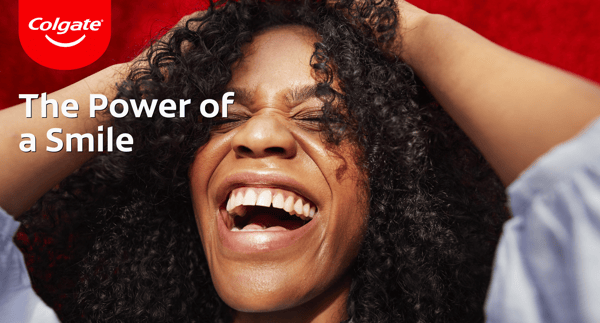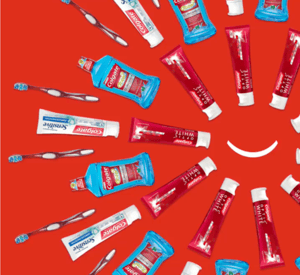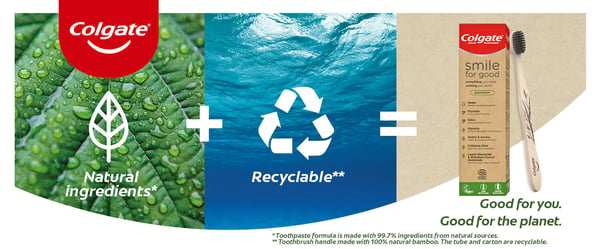Written by
Melissa Lohrer
From toothpaste to dish liquid, skincare to pet food, Colgate-Palmolive touches the lives of billions of people on a daily basis.
When a brand’s presence is not just iconic but historic, what does it take to restage it for growth today without losing the gravity it’s cultivated over centuries?
We had the chance to talk with Jared about evolving Colgate-Palmolive’s portfolio of brands with 200-year-old history, moving beyond commodities in the midst of a pandemic, and the opportunity for big brands to bring about social change.
Evolution guided by purpose
The Colgate brand has a higher household penetration rate than any other, found in 67% of homes globally. The brand is over 200 years old, and its distribution strategy has been around for about half that time. With centuries of history and an unparalleled reach, the brand holds a lot of weight.
“It has a visual identity that people love,” says Jared. “Colgate stands for a healthy smile, which can get you a job, a date, an education, or improve your life.”
The excellent product, distribution, manufacturing, and science have each played big roles in the brand’s success—but design perhaps hasn’t been front and center over the years. To transform with intention, brand purpose had to guide the next evolution.
“Optimism is at the heart of the Colgate brand. We spent formative years building on the back of that purpose, strategy, and belief that Colgate is this bedrock of oral care, that access to good oral care is almost a human right. We make 9 billion packages a year globally. The visual identity is seared into people’s minds, and now that logo connects with memories, purpose, opportunity, and most importantly, optimism. 
Looking back to 2017, what we found when looking at the visual identity is that there were multiple versions of it around the world in different shapes and sizes, but despite that, the brand was still thriving. We thought if we could clean that up, other good things would happen.”
Integrating a design systems approach into a brand that was already so successful required trust. The balance was artful: it required speaking to values, but also maintaining a visual integrity, harkening to the Colgate that already households know and love.
“How is toothpaste optimistic? We found we could make an empirical connection between trust, confidence, and optimism. Once we understood that visual scaffolding, we had a good system.”

This laid the groundwork for the creation of a new asset: the smile element. From there came a brand experience, framework, activation and guide, followed by verbal identity, and most recently sonic and UX experience.
“You can cut down a logo into a UX button moment, to a musical sound on an app, that invokes optimism and courage. It's been such a cool journey.”
Adapting in a pandemic
What does a global pandemic mean for a brand that’s often synonymous with hygiene?
“The name of our company is Colgate-Palmolive, but the shorthand is Colgate,” says Jared. “But in a pandemic, when hand washing becomes a way to fight a virus and restore overall health, brands like Palmolive, that center on soap and cleaning have been reborn because they deliver on fundamental human needs and have an importance that has sometimes been understated.”
It was a moment ripe for changing the conversation—to place the onus on soap as an essential building block of humanity.
Energizing an icon
Every two to three years, Colgate-Palmolive does what it calls a relaunch, which could happen for a number of reasons: for example, to launch new technology, launch in new channels, or to attract new people.
"A relaunch is essentially an opportunity to define and better communicate the most important, distinctive, or valuable things,” says Jared. "You scrub away any visual noise and are left with the essence of the brand.” The more these relaunches play out in Colgate-Palmolive’s favor, the more credibility design has. As the rewards to these risks roll in, the company is getting more and more comfortable making bolder decisions—and design is becoming a bigger enabler of these choices.
The more these relaunches play out in Colgate-Palmolive’s favor, the more credibility design has. As the rewards to these risks roll in, the company is getting more and more comfortable making bolder decisions—and design is becoming a bigger enabler of these choices.
“I must deliver great work. Period. The more we do that, the more trust and confidence in the power of design grows - and smaller projects lead to bigger ones.”
Responsive branding for success
How does a business with tens of thousands of employees, a brand with billions of consumers, and hundreds of teams lead from the top down?
“The short is: we don’t. We've moved to a culture of empowered collaboration. As designers, we can be academic or purist - for example we might say we should 'have one look and feel, one architecture, one global strategy',” says Jared. “But the reality is that on the ground, as a business, our brands need to connect with local people and culture, meaning we need flexible design systems with the right mix of hard and soft points.
So design has chosen to prioritize people over purism. It doesn’t make sense to force, say, a European sensibility on South American consumers who love their brand of bar soap—or vice versa. Rather than homogenizing, design will create toolboxes and systems that will grow individual brands and businesses.
The result? Limitless opportunities.
“What we’ve done on Colgate can be done on a smaller brand like our Murphy Oil Soap; by creating and investing in brand experience, we can activate a blend of traditional and new digital playbooks like social media, to give it a platform and a personality. And the awesome thing is we’ve have all these amazing gem brands that need just a bit more love and they’re going to flourish.”
Looking ahead to social design
Brands do not exist in a vacuum—and neither do the actions, choices, and directives of leaders. Companies, especially global giants like Colgate-Palmolive, have the opportunity to impact social design - the supply and demand of equality and opportunity in a way that creates a more just world.
Design, he says, has always been about making things better. The impact can—and must—expand beyond great consumer experiences to solve larger, societal problems. We’re at a pivotal time for brands to have an impact. Jared offers design and diversity as an example.
“We need to listen more, do more—and do better—and welcome diverse talent to our design team. I’d argue we design for the most diverse audience in the world, being in more homes than any other brand. So our design team should reflect that diversity to better understand different cultures, motivation, and context. Ultimately, we are talking about empathy.
Obviously there are benefits for a business like ours as well. If you’re designing for two to three billion people, different ways of connecting with diverse cultures increases the potential to connect with large groups of people.”
Design leaders know the playbook for scale and impact for products and services. Now it’s time we draw inspiration from past masters of social movements and others making change for the good of the planet to bring those principals to the design movement.
This conversation is part of our series on future-ready brands, where we speak with brand leaders about evolving at pivotal moments. See more conversations with future-ready brands.
Follow us on Linkedin and subscribe to our newsletter for more perspectives like these.
Sign up for the latest news and views
